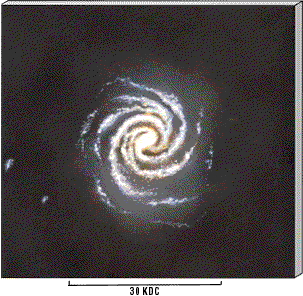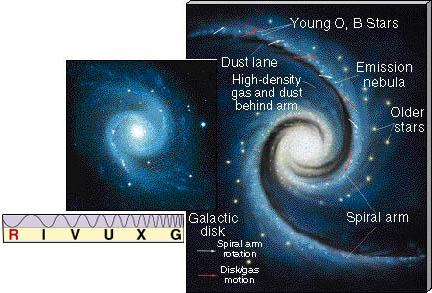If we want to look beyond our immediate neighborhood and study the full extent of the Galactic disk, we cannot rely on optical observations, as interstellar absorption severely limits our vision. In the 1950s, astronomers developed a very important tool to explore the distribution of gas in our Galaxy—spectroscopic radio astronomy.
The keys to observing Galactic interstellar gas are the 21-cm radio emission line produced by atomic hydrogen and the many radio molecular lines formed in molecular cloud complexes. (Sec. 18.4) Long-wavelength radio waves are largely unaffected by interstellar dust, so they travel more or less unimpeded through the Galactic disk, allowing us to "see" to great distances. Because hydrogen is by far the most abundant element in interstellar space, the 21-cm signals are strong enough that a large portion of the disk can be observed in this way. As noted in Chapter 18, observations of spectral lines from "tracer" molecules, such as carbon monoxide, allow us to study the distribution of the densest interstellar clouds.
(Sec. 18.5)
Interstellar gas in the Galactic disk exhibits an organized pattern on a grand scale. According to radio studies, the center of the gas distribution coincides roughly with the center of the globular-cluster system, about 8 kpc from the Sun. (In fact, this figure is derived most accurately from radio observations of the distribution of Galactic gas, the center of which is normally taken to define the center of our Galaxy.) Near the center the gas in the disk fattens markedly in the Galactic bulge. Radio-emitting gas has been observed out to at least 50 kpc from the Galactic center. Over much of the inner 20 kpc or so of the disk the gas is confined within about 100 pc of the Galactic plane. Beyond that distance the gas distribution spreads out somewhat, to a thickness of several kiloparsecs, and shows definite signs of being "warped," possibly because of the gravitational influence of a pair of nearby galaxies (to be discussed in Chapter 24; see also Figure 23.15).
Radio studies provide perhaps the best direct evidence that we live in a spiral galaxy. Figure 23.15 is an artist's conception (based on observational data) of the appearance of our Galaxy as seen from far above the disk, clearly showing our Galaxy's spiral arms, pinwheel-like structures originating close to the Galactic bulge and extending outward throughout much of the Galactic disk. One of these arms, as best we can tell, wraps around a large part of the disk and contains our Sun. Notice, incidentally, the scale markers on Figures 23.9, 23.10 and 23.15: the Galactic globular-cluster distribution (Figure 23.9), the luminous stellar component of the disk (Figure 23.10), and the known spiral structure (Figure 23.15) all have roughly the same diameter—about 30 kpc.

Figure 23.15 An artist's conception of our Milky Way Galaxy seen face-on. This illustration is based on data accumulated by legions of astronomers during the past few decades, including radio maps of gas density in the Galactic disk. Painted from the perspective of an observer 100 kpc above the Galactic plane, the spiral arms are at their best-determined positions. All the features are drawn to scale (except for the oversized yellow dot near the top, which represents our Sun). The two small blotches to the left are dwarf galaxies, called the Magellanic Clouds. We will study them in Chapter 24.
The spiral arms in our Galaxy are made up of much more than just interstellar gas and dust. Studies of the Galactic disk within a kiloparsec or so of the Sun indicate that young stellar and prestellar objects—emission nebulae, O and B stars, and recently formed open clusters—are also distributed in a spiral pattern that closely follows the distribution of interstellar clouds. The obvious conclusion is that the spiral arms are the part of the Galactic disk where star formation takes place. The brightness of the young stellar objects just listed is the main reason that the spiral arms of other galaxies are easily seen from afar (Figure 23.3a).
A central problem facing astronomers trying to understand spiral structure is how that structure persists over long periods of time. The basic issue is simple: we know that the inner parts of the Galactic disk rotate more rapidly than do the outer regions. Thus stars in the Galactic disk do not move smoothly together, but ceaselessly change their positions relative to one another as they orbit the Galactic center. This differential rotation makes it impossible for any large-scale structure "tied" to the disk material to survive. Figure 23.16 shows how a spiral pattern consisting always of the same group of stars and gas clouds would necessarily "wind up" and disappear within a few hundred million years. Yet spiral arms clearly do exist in our own galaxy, and their prevalence in other disk galaxies suggests that they last for considerably longer than this. Thus, whatever the spiral arms are, they cannot simply be dense star-forming regions orbiting along with the rest of the Galactic disk.
Figure 23.16 The disk of our Galaxy rotates differentially—stars close to the center take less time to orbit the Galactic center than those at greater distances. If spiral arms were somehow tied to the material of the Galactic disk, this differential rotation would cause the spiral pattern to wind up and disappear in a few hundred million years. Spiral arms would be too short-lived to be consistent with the numbers of spiral galaxies we observe today.
How then do the Galaxy's spiral arms retain their structure over long periods of time in spite of differential rotation? A leading explanation for the existence of spiral arms holds that they are spiral density waves—coiled waves of gas compression that move through the Galactic disk, squeezing clouds of interstellar gas and triggering the process of star formation as they go. (Sec. 19.5) The spiral arms we observe are defined by the denser-than-normal clouds of gas the density waves create and by the new stars formed as a result of the spiral waves' passage.
This explanation of spiral structure avoids the problem of differential rotation because the wave pattern is not tied to any particular piece of the Galactic disk. The spirals we see are merely patterns moving through the disk, not great masses of matter being transported from place to place. The density wave moves through the collection of stars and gas making up the disk just as a sound wave moves through air or an ocean wave passes through water, compressing different parts of the disk at different times. Even though the rotation rate of the disk material varies with distance from the Galactic center, the wave itself remains intact, defining the Galaxy's spiral arms.
In fact, over much of the visible portion of the Galactic disk (within about 15 kpc of the center), the spiral wave pattern is predicted to rotate more slowly than the stars and gas. Thus, Galactic material catches up with the wave, is temporarily slowed down and compressed as it passes through, then continues on its way. (For a more down-to-earth example of an analogous process, see Interlude 23-2.)
As shown in Figure 23.17, the slowly moving spiral density wave is outrun by the faster-moving disk material. As gas enters the arm from behind, the gas is compressed and forms stars. Dust lanes mark the regions of highest-density gas. The most prominent stars—the bright O and B blue giants—live for only a short time, so young stellar associations, emission nebulae, and open clusters with long main sequences are found only within the arms, near their birth sites, just ahead of the dust lanes. The brightness of these young systems emphasizes the spiral structure. Farther downstream, ahead of the spiral arms, we see mostly older stars and star clusters. These have had enough time since their formation to outdistance the wave and pull away from it. Over millions of years their random individual motions, superimposed on the overall rotation around the Galactic center, distort and eventually destroy their original spiral configuration, and they become part of the general disk population.

Figure 23.17 Density-wave theory holds that the spiral arms seen in our own and many other galaxies are waves of gas compression and star formation moving through the material of the galactic disk. In the painting above, gas motion is indicated by red arrows, and arm motion is indicated by white arrows. Gas enters an arm from behind, is compressed, and forms stars. The spiral pattern is delineated by dust lanes, regions of high gas density, and newly formed O and B stars. The inset shows the spiral galaxy NGC 1566, which displays many of the features described in the text. Note, incidentally, that although both spirals here have two arms each, astronomers are not completely certain how many arms make up the spiral structure in our own Galaxy (see Figure 23.15). The theory makes no strong predictions on this point.
An alternative possibility is that the formation of stars drives the waves, instead of the other way around. Imagine a row of newly formed massive stars somewhere in the disk. As these stars form, the emission nebulae that appear around them send shock waves through the surrounding gas, possibly triggering new star formation. Similarly, when the stars explode in supernovae, more shocks are formed. (Sec. 21.2) As illustrated in Figure 23.18(a), the formation of one group of stars thus provides the mechanism for the creation of more stars. Computer simulations suggest that it is possible for the "wave" of star formation thus created to take on the form of a partial spiral and for this pattern to persist for some time. However, this process, sometimes known as self-propagating star formation, can produce only pieces of spirals, as are seen in some galaxies (Figure 23.18b). It apparently cannot produce the galaxywide spiral arms seen in other galaxies and present in our own. It may well be that there is more than one process at work in the spectacular spirals we see.

Figure 23.18 (a) Self-propagating star formation. In this theory of the formation of spiral arms, the shock waves produced by the formation and later evolution of a group of stars provide the trigger for new rounds of star formation. We have used supernova explosions to illustrate the point here, but the formation of emission nebulae and planetary nebulae are also important. (b) This process may well be responsible for the partial spiral arms seen in some galaxies, such as NGC 300, shown here in true color. The distinct blue appearance derives from the vast numbers of young stars that pepper its ill-defined spiral arms.
An important question (but one that unfortunately is not answered by either of the two theories just described) is: Where do these spirals come from? What was responsible for generating the density wave in the first place or for creating the line of newborn stars whose evolution drives the advancing spiral arm? Scientists speculate that (2) instabilities in the gas near the Galactic bulge, (1) the gravitational effects of our satellite galaxies (the Magellanic Clouds, to be discussed in Chapter 24), or (3) the possible barlike asymmetry within the bulge itself may have had a big enough influence on the disk to get the process going.
The first possibility is supported by growing evidence that many other spiral galaxies seem to have experienced gravitational interactions with neighboring systems in the relatively recent past (see Chapter 24). However, many astronomers still regard the other two possibilities as equally likely. For example, they point to isolated spirals, whose structure clearly cannot be the result of an external interaction. The fact is that we still don't know for sure how galaxies—including our own—acquire such beautiful spiral arms.